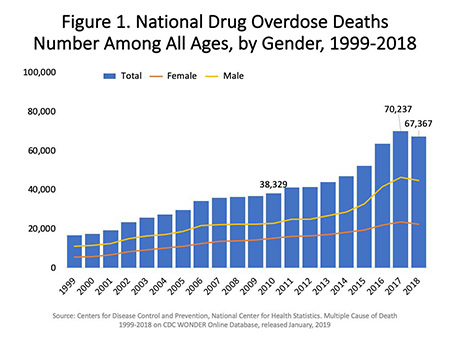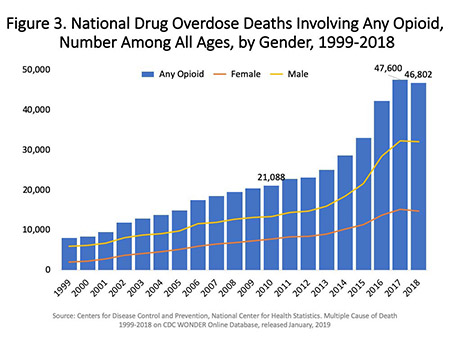Learn
Types
Over-the-Counter Drugs
Drugs are classified as over-the-counter (OTC) or prescription. OTC drugs can be bought without a prescription and are used to treat common problems such as mild pain, colds, and athlete’s foot. These drugs typically have two types of names: trade names and generic names. For example, ibuprofen is a common OTC medication that treats mild pain. Drug companies that produce ibuprofen sometimes give their drug a trade name, such as Advil or Motrin. Some companies sell their drugs using the generic name, such as ibuprofen. All these forms of drugs are the same chemically, but they are produced and marketed by different companies.
Prescription Drugs
Prescription drugs can only be obtained as prescribed by a licensed healthcare provider. They are prescribed for a specific person to treat a specific problem. It is illegal to give or sell prescription drugs to someone else. Drugs are often prescribed to treat bacterial infections, high blood pressure, diabetes, high cholesterol, and many other conditions. It is important to take all medications as prescribed and to discuss any problems with your healthcare provider.
You and your health care provider should discuss the risks and benefits of taking any medicine. When the benefits are greater than the risks, taking medicine can help you live a healthier life. If you have a negative side effect after taking a drug, such as a rash or vomiting, stop taking the medicine and contact your healthcare professional immediately.
Antibiotics
A pathogen is an organism that causes disease. Most short-term illnesses are caused by one of two types of pathogens: bacteria or viruses. Researchers have not yet discovered medicines that kill viruses, but there are medicines that decrease symptoms of many viral infections while the body’s immune system fights off the infection.
Strep throat is caused by bacteria. Bacteria are killed by antibiotics. Taking antibiotics can cause stomachaches and yeast infections. Eating yogurt and other foods that contain probiotics can ease these symptoms. When antibiotics are prescribed, it is important to take all of the medication as prescribed. If all of the medication is not taken, the strongest bacteria survive and can mutate, or change, making them more difficult to kill in the future. The improper use of antibiotics has led to mutating bacteria that are becoming more difficult to kill with available antibiotics. The result is superbugs that are increasingly resistant to antibiotic treatment.
The common cold and flu are caused by viruses. Researchers have not yet discovered medicines that kill viruses, but there are medicines that decrease symptoms of many viral infections while the body’s immune system fights off the infection. Antibiotics do not kill viruses and should not be used for viral infections.
Long-Term Medications
Medications are often prescribed for long-term health conditions, such as high blood pressure, high cholesterol, diabetes, and many other diagnoses. Taking medication for these conditions can keep them from causing more problems. High blood pressure often causes strokes and kidney damage. High cholesterol can cause damage to the blood vessels, leading to heart attacks. Untreated diabetes can lead to life-threatening blood sugar levels and damage to all body tissues.
Pain Medications
Medications used to treat pain are called analgesics. Some analgesics are for mild pain and can be bought over-the-counter. Narcotics can be prescribed for severe pain. Narcotics can lead to addiction and should be used as little as possible for as short a time as possible. Non-narcotic treatments can decrease the use of narcotics.
Transcutaneous electrical nerve stimulation (TENS) units are small devices taped to the skin to deliver low voltage electrical current through the skin. This electrical current overrides the pain stimulus and helps many people manage pain. Over-the-counter medications, TENS units, and distraction through involvement with people and activities can help many people decrease the use of narcotics and avoid addiction.
Children
Medications and Children
Pregnant women should not take any medication without permission from their doctor. Some medications can cause serious injury to the unborn child.
All medications should be locked away where young children cannot reach them. The pharmacist can provide bottles with lids that are difficult for children to open.
Dosage
Many medicines, such as ibuprofen, come in different concentrations for infants, young children, older children, and adults. Children receive different dosages depending on their age and weight. To give the correct dosage, use the preparation and concentration that is right for their age group. Ask your doctor and pharmacist to help you find the right product, and learn how to give the right amount for each child. Read all instructions on the package carefully. It can be easy to overdose a child by not understanding which product to give and how to give it. A family with a newborn, a three year old, and a seven year old will give a different preparation of ibuprofen to each of their three children.
Controlled Substances
Potential for Abuse
Controlled substances are drugs that can have a negative effect on a person. Controlled substances are classified as schedule I through schedule V based on the potential for abuse and dependence.
Schedule I drugs are most likely to be abused and cause dependence, while schedule V are the least likely to cause abuse and dependence. Some controlled substances are illegal in all circumstances. Others can be legally prescribed by doctors.
It is illegal to share or sell drugs prescribed for one person with someone else. Abuse and dependence often happen when legal drugs are used illegally. Even when legal drugs are used legally, problems with addiction can occur.
Drug Abuse
Virtually everyone knows using drugs illegally leads to problems. Some drugs can cause addiction, sometimes called substance use disorder, after trying the drug the first time. So, why do people use drugs illegally? Common reasons include peer pressure, curiosity, boredom, escape from painful circumstances, and following the patterns they have observed in their lives. Using drugs for any of these reasons usually leads to more problems than were present before using drugs.
Many people have been affected by their own bad choices or the choices of those they care about. What have you observed about the impact of drug use on people’s lives?
The Opioid Crisis
While misuse and overuse of all illegal drugs is a problem nationwide, deaths from opioid overdose have risen dramatically. Opioids include prescription pain relievers, heroin, and fentanyl. Opioids are often prescribed for pain after surgery. To avoid addiction it is important to move to non-narcotic pain medicine as quickly as possible.
The graphs below show the increase in death by overdose in recent years. Figure 1 shows overdose deaths from all drugs, while figure 3 shows deaths by overdose of opioids. You can see from these figures that deaths from all drugs have doubled in the past ten years, while deaths from opioids have almost tripled in during the same period. The dramatic increase in deaths from opioid overdose is largely responsible for the decrease in life expectancy in the United States in recent years.


One factor contributing to overdoses is that the concentration of street drugs (unregulated drugs that are not prescribed) is not reliable or consistent. Drugs purchased one day can be much more powerful than drugs previously purchased. There is no government oversight to make dosages dependable and consistent. Many people die because they take a stronger dose of a drug than they realize.
The U. S. government is responding to the opioid crisis through education, research, treatment for those with a substance use disorder, and promotion of better practices for prescribing pain medication. Governments are making naloxone, a drug that reverses the effects of opioids, more available to those with substance abuse disorder. Opioids slow breathing, resulting in death due to a lack of oxygen. Naloxone can save lives by blocking opioids, reversing the effects on breathing. If given quickly, naloxone can prevent death. In some states, family members and others close to people who misuse opioids can be trained to give naloxone in a crisis. Information about naloxone administration in Alabama is available at Alabama Public Health: Naloxone Dispensing.
Avoiding Drug Abuse
When deciding what your choice will be about drugs, educate yourself about the risks of drug use. Consider your life goals. What do you want to accomplish? Will using drugs help or hinder you in achieving your goals? Also consider your values. How do your personal values impact your decision about drug use?
The simplest and most effective way to avoid drug abuse is to simply say “no” every time someone asks. If you say no, people will usually stop asking. If you fear losing friends for saying no, consider finding friends who respect and share your values and want you to be safe. In addition to saying no, it can help to suggest an alternate activity. A group could go to a movie or come over to your house, with your parents present. Do not go places where you expect drugs will be present. Have someone you can call if you find yourself in a dangerous situation.
During the teen and young adult years, most people are exposed to temptations that can make it difficult to achieve life goals. Each person must decide how they will manage choices about sex, alcohol, and drugs. In making those decisions, remember the decision-making process involves considering your options and their consequences. How will each possible choice influence your ability to achieve your life goals and live your values? How might your choices impact your peers and family? You can help yourself and others who are important to you by making good choices.
How to Help Someone
How can you tell if someone is using drugs? Drugs can cause a person to lose interest in school or other activities they previously enjoyed. Drug users often change friends, and begin to spend time with people who use drugs. Drug users might become moody, have difficulty concentrating, and want to be left alone a lot. Drugs often cause people to lose or gain weight, have red or puffy eyes, sniff or have a runny nose, sleep a lot, get in fights, have trouble concentrating, or have decayed teeth. People using drugs might not pay close attention to hygiene and could need to bathe, wash and comb their hair, or put on clean clothes.
How can you help someone you think is using drugs? The most important thing you can do is tell a trusted adult. You can tell a counselor at your school, a parent, teacher, or anyone who can help. People are often afraid of getting someone in trouble, but the trouble will only get bigger if someone does not get help.
Another action you can take to help yourself and others is to say “no” and encourage others to do the same. Everyone knows that using drugs is dangerous. If you are strong enough to say no, someone else might be encouraged by your conviction.
You can listen to the stories of people who have struggled with drug addiction at ADS: Addition, Recovery, And Treatment Video Gallery.
Information
Trusted health care providers, such as your physician, nurse practitioner, pharmacist, or school nurse, can provide credible information about the safe use of drugs. Online sources that provide credible information include the following:
- Centers for Disease Control: Prescription Drugs
- U.S. Food & Drug: Drug Applications for Over-the-Counter (OTC) Drugs
- KidsHealth: What You Need to Know About Drugs
- National Institute on Drug Abuse for Teens
- Recovery.org: Narcotics Anonymous - a group for people struggling with addiction or in a relationship with someone who is addicted